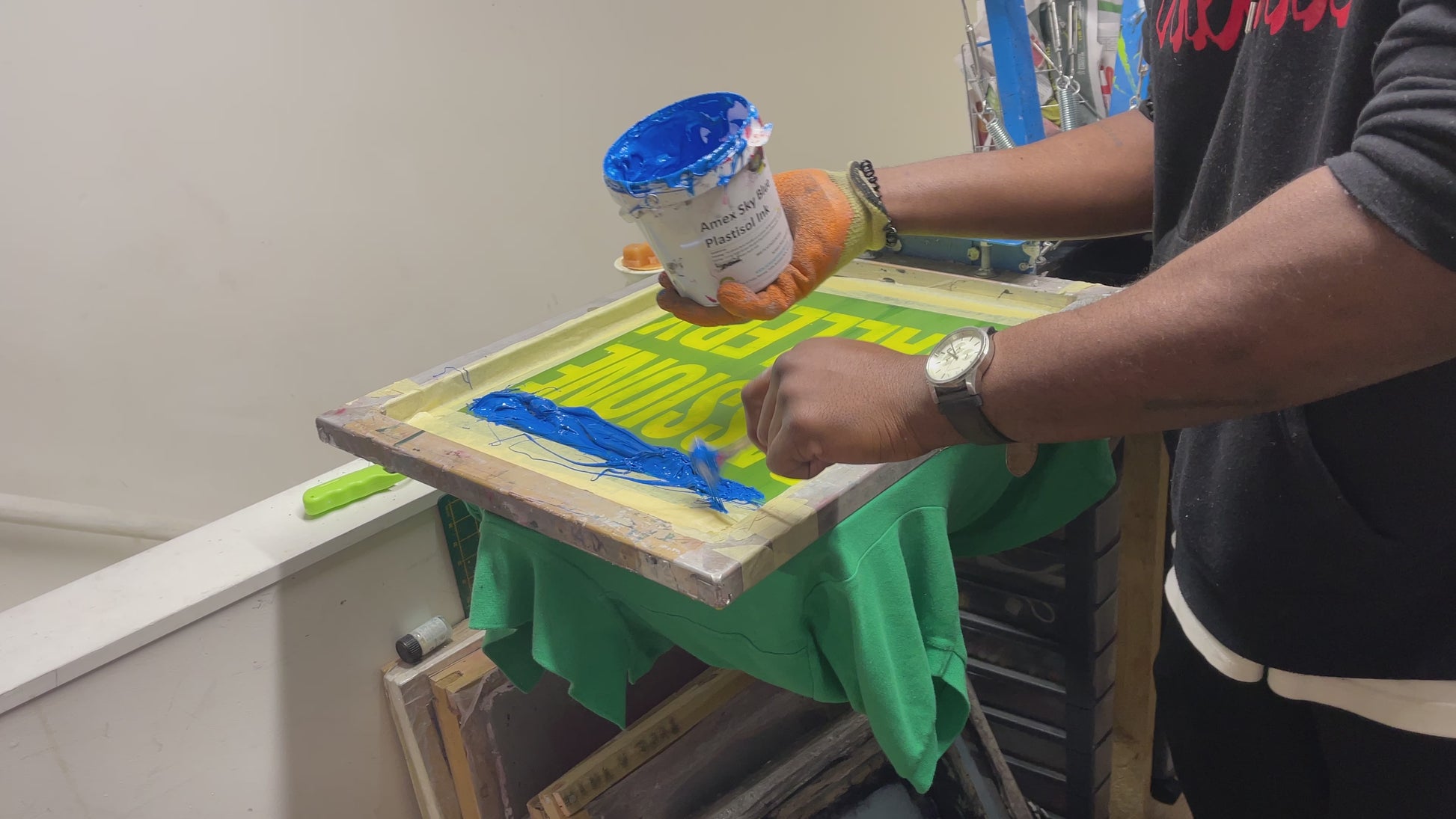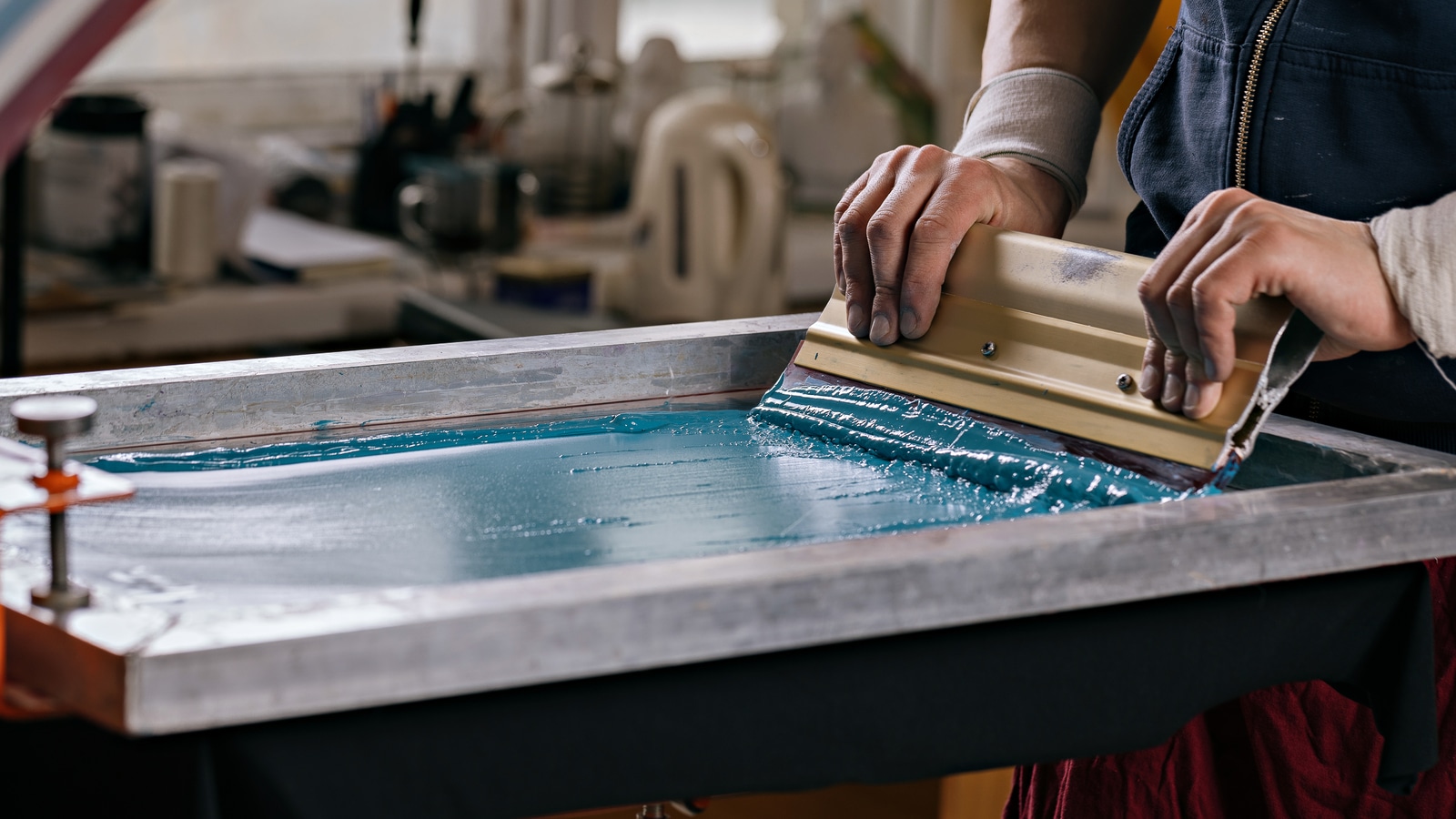Screen Printing Uncovered: Everything You Need to Find Out About Tee Shirt and Garment Printing Techniques
Screen printing is a fascinating method that integrates art with strategy, offering countless opportunities for creativity. Prepared to discover the crucial aspects that make display printing an art form?
The Basics of Screen Printing: Just How It Functions
When you plunge into display printing, you'll uncover it's both a science and an art. At its core, display printing includes creating a pattern, or display, that allows ink to travel through only in particular areas (screen printing kit). You begin by picking your design and preparing your screen with a light-sensitive emulsion. Once you reveal this solution to light, it hardens, leaving your style as a negative area.
Following, you'll mix your inks and prepare your printing surface area. Placement the display over the textile, after that make use of a squeegee to press ink with the display onto the garment. This process needs precision, as you want clear, vivid prints. After printing, you'll treat the ink with heat, ensuring it adheres to the material and lasts via cleans. Each action is vital, and understanding them will boost your display printing abilities, changing simple garments right into one-of-a-kind, meaningful pieces.
Kinds of Screen Printing Methods
When you realize the fundamentals of screen printing, it's time to discover the numerous methods that can elevate your layouts. One popular technique is conventional screen printing, where ink is pushed via a stenciled screen. This technique is terrific for bold, dynamic shades. There's water-based ink printing, which supplies a softer feeling and is eco-friendly, yet it needs a different method to curing.
If you're going for fine details, think about discharge printing. This strategy gets rid of dye from the textile, leaving a soft, classic appearance. Another choice is plastisol printing, understood for its resilience and dazzling colors, making it a favored for many brands. Lastly, try out halftone printing to create slope impacts and detailed styles. Each method has its one-of-a-kind beauty, so don't wait to attempt them bent on locate what suits your style best!
Necessary Devices for Display Printing
To achieve sensational lead to display printing, having the appropriate tools is fundamental. You'll need a durable display printing framework, which holds the mesh that moves your style onto the garment. Next, purchase top notch mops; these are necessary for applying ink uniformly across the display. You'll additionally call for an excellent direct exposure unit to develop your displays, in addition to a washout booth for cleaning them after use. A reputable warmth resource, like a conveyor clothes dryer or heat press, is critical for curing your prints to ensure long life. Do not fail to remember an appropriate office, outfitted with tables and storage space for your products. Ultimately, protective gear, such as masks and gloves, will keep you risk-free from chemicals and inks. With the right tools, you'll be well on your method to producing professional-quality prints.
Picking the Right Inks and Materials
When picking inks and products for screen printing, you require to take into consideration the kind of ink that works best for your project. Think concerning textile compatibility to ensure your styles look last and wonderful lengthy. Check out green ink choices to make your printing procedure extra sustainable.
Kinds Of Screen Inks
Picking the right screen ink is necessary for accomplishing dynamic, durable prints that satisfy your task's requirements. There are numerous types of display inks to take a look at. Specialty inks, such as glow-in-the-dark or metallic, can add special effects to your layouts.

Fabric Compatibility Factors To Consider
Recognizing fabric compatibility is essential for attaining premium display prints, specifically because various products respond distinctly to different inks. When picking inks, think about the fabric type-- cotton, polyester, or blends. For cotton, water-based inks function well, using soft qualities and breathability. Polyester, on the various other hand, typically requires plastisol inks for better bond and vibrant colors. If you're printing on blends, you might need to utilize a combination of both types. Always examine your inks on sample textile to assure they adhere appropriately and preserve color integrity. Furthermore, maintain in mind that material weight and structure can influence the final outcome, so choosing the best ink and product combo is important for your job's success.
Eco-Friendly Ink Options
Environmentally friendly inks are ending up being a preferred option for display anonymous printers that want to lessen their ecological effect while preserving top quality. When choosing inks, think about water-based inks, which are less harmful and easier to tidy up compared to typical solvents. These inks bond well with materials, providing dynamic outcomes without poisonous chemicals. You might also explore eco-solvent inks that make use of fewer volatile natural substances (VOCs), making them a much safer option for both your health and wellness and the world.
Additionally, try to find inks made from renewable sources, such as soy or vegetable-based alternatives. By picking the right inks and products, you'll not only develop stunning styles but additionally add to a much more lasting printing procedure. Make the button, and your prints will reflect your dedication to the setting!
Preparing Your Design for Screen Printing

Submit Layout Needs
To assure your design looks sharp and vivid on material, you'll require to pay close focus to file style demands for screen printing. Make certain your style has a clear background to avoid unwanted white edges on your prints. Keep color settings in mind; CMYK is standard for screen printing, so transform your RGB makes accordingly.
Shade Splitting Up Methods
Color separation is an essential action in preparing your style for display printing, and understanding it can greatly enhance your print high quality. You'll need to damage your design right into individual shades, as each color calls for a separate screen throughout printing. This precision not only guarantees accurate shade depiction but likewise simplifies the printing process.
Resolution and Size
Accomplishing the most effective cause display printing starts with assuring your style has the best resolution and size. Preferably, your artwork ought to go to least 300 DPI (dots per inch) for sharp, clear prints. Your final product might look pixelated and amateur. if you utilize lower resolution.
When it comes to dimension, think about the dimensions of your print area. Layout your artwork to match the final print size, preferably developing it in the actual dimensions you'll be publishing. In this manner, you'll avoid any type of unanticipated scaling issues.
Always inspect your layout in both vector and raster layouts. Vector graphics can be scaled without losing high quality, making them suitable for screen printing. Preparing correctly will ensure your style looks amazing on every garment!
Step-by-Step Display Printing Refine
Screen printing is a dynamic process that enables you to produce vivid layouts on numerous surfaces. To start, you'll need a screen, emulsion, and your selected ink. Prepare your display by cleansing it completely. Next off, apply the emulsion uniformly and allow it completely dry in a dark location. When completely dry, subject your screen to light with your design positioned on it, which will harden the emulsion where the light hits, producing a stencil - screen printing kit.
After rinsing the unexposed solution, your screen prepares. Establish it up on your printing surface and align your garment under it. Put ink onto the display and make use of a squeegee to press the ink via the pattern onto the textile. Raise the display thoroughly and let the print completely dry. Heal the ink making use of warmth to ensure sturdiness. That's it! You have actually effectively display published your layout.
Tips for Effective Display Printing Projects
While you're diving into your screen printing tasks, keep in mind that preparation is vital to success. Begin by collecting all your materials-- inks, garments, screens, and mops. A clean office aids stop unwanted mistakes, so clean prior to you start.
Next, verify your artwork is high-resolution and effectively sized for your garment. Test your display for appropriate direct exposure and tidy it thoroughly to prevent smudges. When mixing your inks, follow the maker's standards to accomplish the right uniformity.
During printing, use even pressure with your squeegee for consistent outcomes. Do not hurry; take your time to confirm each print fulfills your requirements. After printing, let your garments completely dry completely prior to dealing with or packaging them.
Finally, constantly keep a sample of your benefit future recommendation. In this manner, you can examine your progression and enhance your methods over time. Happy printing!

Often Asked Questions
Just how Long Does It Require To Establish a Display Printing Work?
Establishing a screen printing work typically takes around 30 mins to an hour. You'll prepare the screens, mix inks, and change the press. The time varies based upon complexity and experience, so stay arranged!
Can I Publish on Different Fabric Types Making Use Of the Very Same Method?
Yes, you can print on various textile kinds making use of the very same strategy, but you'll need to adjust your inks and settings. Some materials soak up ink in a different sites way, so exploring guarantees the most effective outcomes for each and every material.
What Are Typical Blunders to Stay Clear Of in Display Printing?
When display printing, prevent typical mistakes like using the incorrect ink, overlooking correct direct exposure times, or missing pre-press checks. Constantly examine your arrangement and maintain clean displays to guarantee quality outcomes each time.
Just How Can I Correctly Tidy and Maintain My Screen Printing Equipment?
To correctly clean and keep your display printing equipment, Going Here you must frequently wash screens with suitable solvents, check mops for wear, and assure all devices are kept dry and dust-free. Uniformity stops expensive repairs and improves performance.
Is Screen Printing Eco-friendly Contrasted to Other Approaches?
Screen printing can be a lot more eco-friendly than other approaches, especially if you utilize eco-conscious materials and water-based inks. By selecting lasting supplies and methods, you lower waste and reduce your influence on the planet.
Display Printing Uncovered: Everything You Required to Know About Tee and Garment Printing Techniques
At its core, display printing includes creating a stencil, or screen, that allows ink to pass through only in certain areas. Position the screen over the textile, then use a squeegee to press ink via the screen onto the garment. One popular approach is traditional display printing, where ink is pushed with a stenciled display.When choosing inks and products for display printing, you require to take right into account the type of ink that functions best for your task.
Comments on “High-Volume T-Shirt Printing for Schools and Organizations”